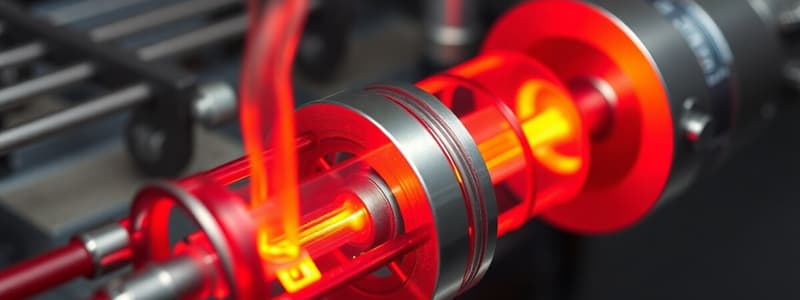Podcast
Questions and Answers
A homebuilder is deciding between different heating systems for a new house. They want a system that is energy efficient and can distribute heat evenly throughout the house. Which two systems would be most appropriate?
A homebuilder is deciding between different heating systems for a new house. They want a system that is energy efficient and can distribute heat evenly throughout the house. Which two systems would be most appropriate?
- Solar and forced-air systems
- Electric and solar heating systems
- Forced-air and radiator systems (correct)
- Radiator and electric heating systems
A sealed container of gas is compressed rapidly. According to the first law of thermodynamics, what will be the most likely effect of this compression?
A sealed container of gas is compressed rapidly. According to the first law of thermodynamics, what will be the most likely effect of this compression?
- The thermal energy of the gas will increase due to the work done on it. (correct)
- The mechanical energy of the gas will increase proportionally to the compression.
- The mechanical energy of the gas will remain constant as the system is sealed.
- The thermal energy of the gas will decrease, and the container will cool down.
In a scenario where a perfectly insulated container has a gas that expands and performs work on its surroundings, what must happen according to the first law of thermodynamics?
In a scenario where a perfectly insulated container has a gas that expands and performs work on its surroundings, what must happen according to the first law of thermodynamics?
- The thermal energy of the gas increases, and the temperature rises.
- The temperature of the gas remains constant because the container is insulated.
- The thermal energy of the gas decreases, and the temperature drops. (correct)
- The mechanical energy of the gas increases to balance the change.
A car engine converts chemical energy into mechanical energy and heat. Considering the principles of thermodynamics, which statement accurately describes this process?
A car engine converts chemical energy into mechanical energy and heat. Considering the principles of thermodynamics, which statement accurately describes this process?
A student is designing an experiment to demonstrate the first law of thermodynamics. They use a sealed container with a piston. Which action would best illustrate the conversion of work into thermal energy?
A student is designing an experiment to demonstrate the first law of thermodynamics. They use a sealed container with a piston. Which action would best illustrate the conversion of work into thermal energy?
Flashcards
Mechanical Energy
Mechanical Energy
The sum of potential and kinetic energy in a system.
Forced Air System
Forced Air System
A heating system that heats air in a furnace and blows it through ducts.
Heating System Types
Heating System Types
Radiator, electric, and solar systems. They all heat differently.
Thermodynamics
Thermodynamics
Signup and view all the flashcards
First Law of Thermodynamics
First Law of Thermodynamics
Signup and view all the flashcards
Study Notes
- Mechanical energy is the sum of the potential energy and the kinetic energy in a system of objects.
Heating Systems
- Forced-air systems are the most common type of heating used in the United States.
- In forced-air systems, air heated by the furnace gets blown through ducts that usually lead to every room.
Other Types of Heating Systems
- Radiator systems
- Electric heating systems
- Solar heating systems
Thermodynamics
- Thermal energy, heat, and work are related.
- Thermodynamics is the study of the relationships between thermal energy, heat, and work.
- The first law of thermodynamics states that if the mechanical energy of a system is constant, the increase in thermal energy transfers into that system and the work done on that system.
Studying That Suits You
Use AI to generate personalized quizzes and flashcards to suit your learning preferences.




